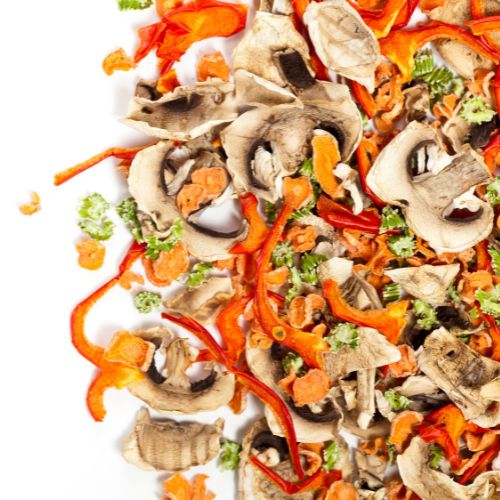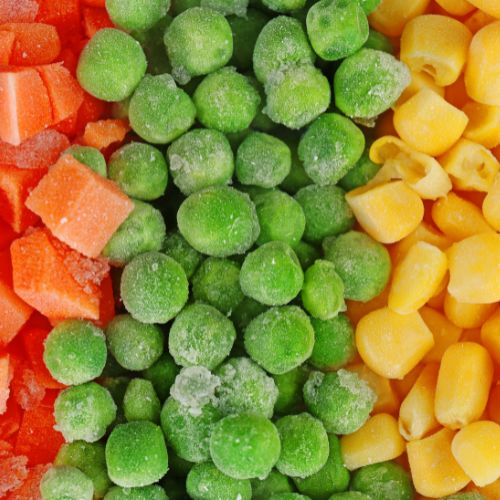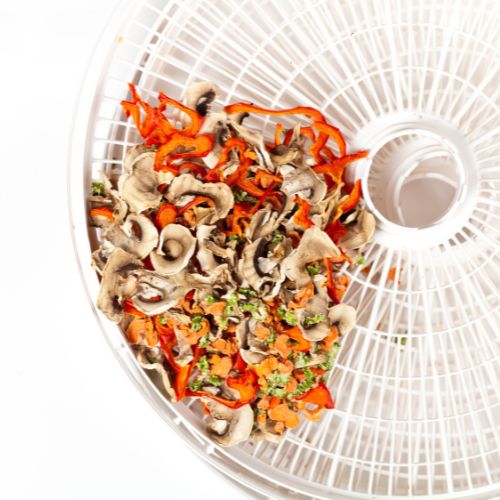So, you have a dehydrator and you don’t have a clue about what dehydrating recipes to do with it. You ask your friends and most of them will tell you to tackle something really easy like apples or mushrooms. While those are fairly easy to dehydrate, there’s something that is so completely easy to do, it will let you clean out your freezer, and be something useful in its final dehydrated stage. It will give you a huge confidence boost that you can do this! So, here are ways to dehydrate frozen vegetables.

Tips to Dehydrate Frozen Vegetables
Vegetables that are in your grocer’s frozen food aisle are usually picked and flash-frozen immediately after the blanching process. They don’t sit in the bin for weeks waiting for some hapless soul to purchase them as fresh vegetables do. They also don’t sit in the fridge for weeks before the poor hapless soul realizes she’s purchased said vegetable and hasn’t a clue what to do with it. Also, there’s white fuzz growing on it, or weird arms and legs coming out of it like a crazy potato with alien appendages. You can go with the organic variety or not. I’m not judging either way.

Really. This is super easy to do. What is simpler than whacking a package on the counter once or twice to make sure there are no clumps, cutting it open, pouring it on your dehydrator trays, and turning the machine on? 6-10 hours later, you come away with some amazing little nuggets of vegetables that are great for just chucking into soups or stews or even grinding into alternative flour or powder.
Wait? What? Did I say alternative flour? Yep, and more on that in a minute. Let’s get through the dehydrating process first.
A Quick Tip about Dehydrating: If you can eat it raw, you generally don’t need to blanch it. If you normally eat it cooked, you need to blanch it. The easy part of doing frozen vegetables – they’ve already been blanched for you! So no need to do the big pot full of boiling water, tossing your prepared and cut up veg in for a minute, then putting them in an ice bath to stop the cooking process, etc. This is quick and easy!
How To Dehydrate Frozen Vegetables?
No products found.1. Open a pack of frozen vegetables.
2. Spread out on your dehydrator tray.

3. Set the dehydrator to 125F.
4. Begin to check at the 6-hour mark. Some frozen vegetables dehydrate more quickly than others. If you are using a bulky mix of vegetables, you might want to pull out the fully dehydrated vegetables to let the bulky ones keep going.
5. Store in an airtight container. These could either be stored in mylar bags, canning jars (either vacuum-sealed or with oxygen absorbers), or zip-top bags (this is for short-term storage only).
Tips:
- When I pulled these out, I found that I had to throw the okra back in for a little longer as it was still a little pliable. If you have larger chunks of veg, you can leave them out for a little while and cut them down before throwing them into the dehydrator, or pull everything else out and let the larger chunks go a bit longer.
- Also, if you have chunks of frozen veg that are in icy chunks, just tap your bag on the counter a few times to break those chunks up. You can also let them sit on your counter for an hour or so to melt some of that ice away and just put the veg on a linen cloth to soak up the excess moisture before pouring it onto your trays. However, some moisture won’t be a problem as it will evaporate away during the process.
What to Do with Dehydrated Frozen Vegetables?
- Throw a few handfuls in a soup or stew. This will bulk up your vegetable quotient and you don’t have to prepare anything ahead of time.
- Grind it to make a vegetable powder that you can toss into things like meatloaf, any casseroles, curries, burgers, smoothies, etc., to bulk up your vegetable intake. Much like making green kale powder. You can even add vegetable powder to sour cream or soft tofu or yogurt to create a dipping sauce.
- Use the corn to grind and make cornmeal.
Here is the dehydrator that I used, though I’ve also used another dehydrator for years and loved it. In addition, I have this Food Saver for vacuum-sealing my jars and use both the wide-mouth and regular-mouth attachments. If you’re a book person and would love to have a book in your kitchen full of awesome ways to dehydrate all kinds of foods and make meals from them, check out the Ultimate Dehydrator Cookbook.
Final Thoughts
Go ahead. Give it a try. Go to your freezer and pull out those old, lumpy frozen vegetable bags and do something with them! Even if they are a little freezer burned, it’s okay. Fresh is always best, but in this instance, in these circumstances, no one is ever going to know! And it’s SOOOOO easy! Avoid wasting your vegetables by throwing them. If they have been in your fridge for a while now, don’t worry. We can still make use of them. There is still more that we could do. Make sure to follow the step-by-step procedure on how to do it.
Katy Willis is a writer, lifelong homesteader, and master herbalist, master gardener, and canine nutritionist. Katy is a preparedness expert and modern homesteader practicing everyday preparedness, sustainability, and a holistic lifestyle.
She knows how important it is to be prepared for whatever life throws at you, because you just never know what's coming. And preparedness helps you give your family the best chance to thrive in any situation.
Katy is passionate about living naturally, growing food, keeping livestock, foraging, and making and using herbal remedies. Katy is an experienced herbalist and a member of the CMA (Complementary Medical Association).
Her preparedness skills go beyond just being "ready", she's ready to survive the initial disaster, and thrive afterward, too. She grows 100% organic food on roughly 15 acres and raises goats, chickens, and ducks. She also lovingly tends her orchard, where she grows many different fruit trees. And, because she likes to know exactly what she's feeding her family, she's a seasoned from-scratch cook and gluten-free baker.
Katy teaches foraging and environmental education classes, too, including self-sufficient living, modern homesteading, seed saving, and organic vegetable gardening.
Katy helps others learn forgotten skills, including basic survival skills and self-reliance.
She's been published on sites such as MSN, Angi, Home Advisor, Family Handyman, Wealth of Geeks, Readers Digest, and more.
Last update on 2024-07-26 at 22:54 / Affiliate links / Images from Amazon Product Advertising API


My dehydrator doesn’t have a temperature control. Does that matter? Thank you
Hi Rhonda, the dehydration process should still work as described in the post but you will need to monitor the process. Most dehydrators that do not have a temp control will have a “default” temperature. I would find out what yours is and then adjust time accordingly.
My dehydrator doesn’t have temperature control does that make a difference?
I am looking for about your product place lace me a messages. When I post this . I am looking for more information no this .
This work on any hydrated at all or can you put them in FoodSaver bags at your dry mouth
I am in the process of dehydrating mango and pineapple chunks that have been hanging out in my freezer for a year!
That’s amazing! Keep us posted about your progress!